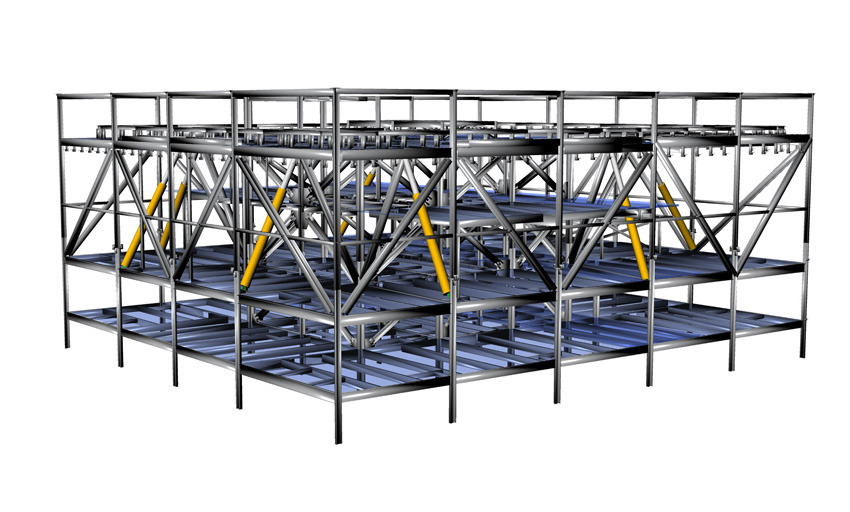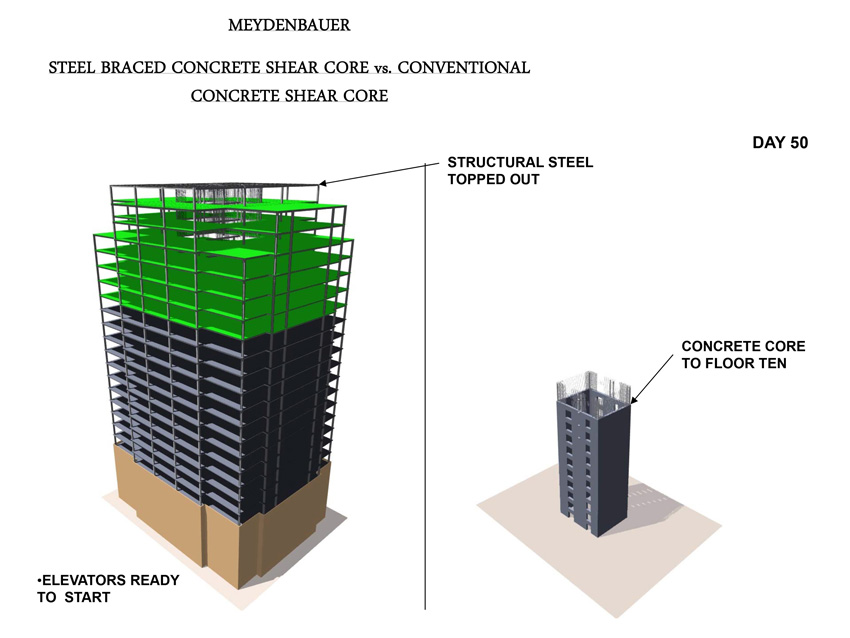The Core of the Matter
Damping Systems
In cases where the core is not stiff enough, another option is adding dampers to control building movement.
“For mid-rise towers, the use of supplemental damping may make steel-braced cores or all steel towers more attractive due to the lower material requirements and the improved single trade construction,” reports Gottlieb.
“Effective damping systems, such as tuned mass dampers, liquid column dampers, or distributed viscoelastic dampers, have made lightweight, taller towers with steel cores more viable,” he continues. “Supplemental damping systems are often explored as ways to improve the performance of steel core buildings without having to add material.”
Acting to reduce the amount of required structural framing, dampers are also advantageous for improving predicted accelerations that the occupants will experience in the event of abnormal wind conditions or a seismic occurrence.
Mass dampers are commonly used to mitigate wind events, although Jackson says that viscous dampers, which are also appropriate for seismic regions, have been specified and offer the benefit of achieving the same damping effect with less weight and space.
Case in point, at the 40-story office tower at 250 West 55th Street in New York City—designed by architect SOM and structural engineer Arup—viscous dampers were found to be the most effective way to handle the building’s wind loads.

Image courtesy of Arup
Thanks to a novel arrangement of viscous dampers, incorporated with a series of outriggers connecting the core to the building perimeter, only seven dampers were required, thereby reducing the overall system cost to less than half of a conventional tuned mass damper system.
In this particular case, wind tunnel testing conducted at the end of the schematic design found that the loading on the building from the wind was less than that required by the code. Furthermore, as explained by Jackson and his colleagues in an American Society of Civil Engineers 2014 Structures Congress white paper, accelerations that occupants would experience at the top of the tower were predicted to be higher than desirable, according to most guidelines. Contributing to this situation was the fact the lower floors were predicted to experience significant shielding from other buildings, while the higher floors were subject to buffeting from the wind interacting with surrounding tall buildings.
Because the actual wind loads were lower than those the building was designed to handle, this potentially allowed for some steel tonnage to be removed. However, there was concern that the reduced steel would further increase accelerations. So in order to capitalize on the cost-effective possibility of reducing the overall amount of steel, various damping solutions were investigated.
For starters, mass dampers and tuned liquid column dampers were considered, but this would have required significant rearranging of the mechanical room—the ideal location for the dampers—that was originally designed to be at the top of the tower.
Fortunately, the design team came up with a novel arrangement of viscous dampers, which involved incorporating the dampers into a series of outriggers connecting the core to the building perimeter, explains Jackson. As a result of arranging the dampers into this outrigger configuration—and damping the dominant flexural deformation rather than shear deformation—only seven dampers were ultimately required.
Jackson and his colleagues also note that the damper design for this project was quite different from those normally used in seismic projects in that damping had to be provided at very small displacements, while constantly cycling whenever there are high winds. In order to address this requirement and to deliver a long service life free of maintenance, they specified dampers without conventional seals.
Another design challenge was the fact that the viscous damping system had to be analyzed as a part of the overall structure as opposed to a separate bolt-on system, such as is the case with a tuned mass damper.
As delineated in an October 2013 AISC Modern Steel Construction article on the project, the design team was able to use conventional analysis processes for the vast majority of the design, as most of the steelwork was not controlled by the damper forces. But for the analysis and optimization of the damping systems themselves, the team used MSC-Nastran.
“When you introduce a viscous damper in place of a steel brace, for example, the way it behaves is not captured correctly by a normal analysis, so different software is needed to analyze these damping elements,” explains Jackson.
Ultimately, despite all that was involved in specifying the viscous dampers, the overall system cost was less than half the cost of a conventional tuned mass damper system.
Steel Concrete Composite Systems
Capitalizing on the strength and stiffness of concrete, together with steel’s slender, lightweight profile, newer steel concrete composite core systems are providing designers with yet another viable option.
One developing version of this composite mix is the steel-braced concrete shear core, designed by Garland’s firm LBL BUILDS. The approach utilizes redundant structural steel columns inside concrete shear walls, which enables the structural steel and rebar curtains to be erected concurrently and in advance of the concrete wall placements.
“With a conventionally constructed concrete shear core, the construction team is challenged to erect two completely separate buildings: the advanced concrete core and the structural steel building frame,” explains Garland. “This discontinuity is time consuming, costly, and suffers from interruptions, mobilization, and demobilizations of various trade activities because the two different building erections proceed at significantly different paces.”
On the contrary, “the most significant advantage of the steel-braced concrete shear core is that the concrete work follows the structural steel erection, rather than the other way around,” says Garland. As a result, this approach is capable of delivering approximately 5 percent in hard cost savings, as compared to a conventional concrete system.

Image courtesy of LBL BUILDS
In comparing a steel-braced concrete shear core to a conventional concrete core, erection time proceeds at an average of two stories per day faster. As illustrated here, the structural steel of this mid-rise tower has been topped out in the time it takes to build a 10-story concrete core.
As described by Garland, the system offers the following benefits from a construction perspective:
- It’s easier to raise the concrete shear core out of the ground, and no complicated rebuilding of the concrete forming systems, as the story height changes, is necessary.
- The concrete work follows the structural steel, as opposed to the steel erection waiting for the concrete core to be constructed.
- The steel-braced core does not require separate construction facilities, as the separate man/material hoist and separate stair towers for the core construction are eliminated.
- Structural tolerances inside the concrete core are easier to manage.
- The structural steel building erection can continue uninterrupted, as there is no need to wait for the core.
- Elaborate climbing or jump-style concrete core forming systems are not required.
- For a conventional 20-story office building, the steel-braced concrete shear core can reduce the construction time by two days per story. In taller buildings, even more time is saved.
- The permanent building elevators can be installed and brought online before a comparable conventional concrete shear core has topped out.









